Job Change After I-140 Approval
The approval of a green card is an exciting time for most immigrants. However, many wonder how long they must stay with their employer without facing penalties or jeopardizing their green card application process. In this post, we’ll explore the process of a job change after green card approval, what to expect, and more detailed scenarios.
USCIS grants green cards based on the premise that the employee permanently accepts the job or position. As many assume, permanent does not necessarily mean you’ll be at the job forever or until you retire. “Permanent” for the sake of immigration means “an indefinite basis.” Moreover, the law suggests the employee intends to remain at the job indefinitely at the point of approval. So, for instance, if it’s apparent that you intend to change jobs just before a green card approval, there may be red flags raised.
Remember that an I-140 approval does not automatically guarantee your green card. Changing your job before you physically receive your visa will incur problems if not handled correctly. However, if you are currently holding your green card in your hands, you can change jobs without notifying the USCIS.
Also, if you are applying for the EB-1A or EB-5 green cards, you do not need a job offer, so your green card is not contingent on which position you hold.
Job Change After I-140 Approval: Process
Job change after green card approval might happen with two groups of people:
- You’re changing your position with your current employer.
- You are changing employers altogether.
If you are staying with your employer and your job title and description are only changing slightly, you might be able to file an I-140 amendment. This will help to ensure USCIS has the most accurate records of your case.
However, when you completely change employers at any point in the green card process after filing the I-140, you must have that employer file a new I-140. Additionally, that employer also needs to obtain a new PERM Labor Certification for you if your green card requires one.
Your PERM is for a distinct position for a specific employer in a particular geographic location. If any of those things change, then the PERM can no longer do its job to protect the jobs of U.S. workers. Because of this, if you’re changing jobs and employers before or after I-140 approval, you need a new PERM. In addition, the employer must run another recruiting period. Also, the employer will be exposed to the possibility of an audit.
On the bright side, by indicating on the new petition that you would like to retain the priority date of your original petition, you can avoid having to restart the priority date waiting time. You could potentially save yourself years of waiting time.
Retaining your priority date is also the trick to “porting” your green card. If, while waiting for your date to be current, you gain eligibility for a higher preference green card, a new sponsoring employer can file a new petition and PERM and still retain your priority date.
Changing Green Card Categories After I-140 Approval
Apart from changing jobs and/or employers after I-140 approval, you may also port your petition from one green card preference level to a higher one. This is more common and advantageous for applicants pursuing the EB-3 green card, as they can leverage the provision to upgrade to an EB-2 green card.
Over the years, there has been a significant difference between the processing times of EB-2 and EB-3 green card categories. The waiting time for certain countries demonstrates this difference. While some applicants may not have a choice other than to wait, others may be able to use the portability rule to their advantage. Examples include those who, in the process of waiting, have:
- received new job offers that meet the eligibility criteria for a higher preference green card category
- have additional job experience that qualifies them for an EB-2
- had an increase in job salary in relation to the increased complexity of their job duties
Suppose you have experienced any of the above scenarios. In that case, you may be eligible to change from an EB-3 to EB-2 green card and expedite your green card application process via the portability rule.
I-140 Portability: How to Port from EB-3 to EB-2
Meeting the above requirements does not mean you have automatically ported from one green card to another.
Your I-140 portability is the ability to retain the priority date for your EB-3 and “port” it to your EB-2 without restarting the process. However, it functions as petitioning for a brand new green card in all other aspects. It requires your employer to file a new PERM Labor Certification and Form I-140 petition. The new petition must reflect the latest achievements that now qualify you for the higher preference category. Be sure to indicate on the petition that you want to retain your priority date.
Learn How to Change Jobs After NIW Approval.
Can I Use the Approved I-140 to File an H-1B with a New Employer?
Yes, you may use the approved I-140 petition to request an H-1B extension and/or change of employer as long as the I-140 remains valid. This may grant you an extension beyond the maximum six-year period of stay. However, if USCIS revokes the petition, you will no longer be allowed to leverage it to request an H-1B status extension beyond the standard maximum of six years.
H-1B Extension After I-140 Approval
With a pending or approved I-140, you can easily extend your H-1B status beyond the six-year maximum and be exempt from cap-subject H-1B filing. The length of the extension will depend on the status of the I-140 petition.
If USCIS approves the I-140, you can request to extend your H-1B status for up to three years. However, if the I-140 is still pending, you can only request a one-year H-1B extension, provided your PERM has been filed for at least 365 days. But without a PERM or I-140, you will have to leave the United States at the end of the six-year validity period.
Another option is to upgrade your pending I-140 petition with premium processing if your six-year stay is about to expire and you don’t want to leave the U.S. With that, you will receive a decision on your petition within 15 calendar days.
However, if the green card category you are pursuing does not have the option of premium processing (such as the EB-1C), H-1B time recapturing, according to S. 31.3 (g)(9) and (14), is another option you can leverage. This means extending your stay in the U.S. by utilizing your time outside the U.S. during the six years. You will need to present proof, such as boarding passes and hotel reservations, as supporting evidence of time spent outside the United States.
Job Change After Green Card Approval With AC21
The AC21 (The American Competitiveness in the Twenty-First Century Act of 2000) has a few essential provisions centered on job flexibility for adjustment of status applicants who face long or delayed processing times. More specifically, it permits an approved I-140 to stay valid as long as:
- The I-485 has been pending for a minimum of 180 days. This period begins from the receipt date of the I-485 (not necessarily the notice date).
AND
- The new job is in the same or similar occupation.
Below is the provision of the law directly from USCIS:
A petition under subsection (a)(1)(D) [redesignated as (a)(1)(F)] for an individual whose application for adjustment of status pursuant to section 245 has been filed and remained unadjudicated for 180 days or more shall remain valid with respect to a new job if the individual is changing jobs or employers if the new job is in the same or a similar occupational classification as the job for which the petition was filed.
Suppose USCIS approves your I-485 in less than 180 days and you are interested in changing jobs after green card approval. USCIS will investigate whether you had the intention to file for that sponsoring employer while filing your application. The longer you can stay with your petitioning/sponsoring employer, the better your case is.
What Falls Under “Similar Occupation?”
There is confusion about what qualifies as a similar job in many instances. The DOL’s online occupational classification system helps the adjudicating officer make the determination. The DOL uses what’s known as the Standard Occupational Classification to properly group and classify jobs. Check the BLS website to learn where in this classification system you fit.
Be aware, however, that this system can sometimes be outdated, and IT jobs often lack up-to-date definitions. Therefore, the best measure is to change jobs where the titles and job descriptions are as similar as possible.
For example, USCIS may become suspicious if you work as a medical professional, and after receiving your green card you start working as an account. In any case, you should consult a green card attorney in these types of dilemmas.
Job Change After I-140 Approval FAQs
Our immigration attorneys are often asked a lot of questions about this topic. Below we compiled answers to the most commonly asked questions:
My I-140 is Approved, What’s Next?
When your I-140, Immigrant Petition for Alien Worker, is approved, you can begin the process to apply for Lawful Permanent Residency in the U.S. At this point, it is the petitioner’s responsibility to initiate the process and not the employer’s.
There are 2 options for you to begin your LPR process once your I-140 is approved. The first option is to file your I-485 Application to Adjust Status through the consular processing route. If you do so, you must apply abroad through the U.S. Embassy or the Consulate of your country of origin. This will also involve attending the interview abroad. The second option is to submit your I-485 within the U.S., which does not require you to travel abroad to complete the LPR process.
Can My Employer Revoke My I-140 After USCIS Approved It?
Your petitioning employer may decide to send a withdrawal notice to USCIS, especially if you did not part ways on good terms. However, the timing of the withdrawal will determine whether USCIS will revoke the I-140 or not. For example, if the withdrawal request came within 180 days of the I-140 petition approval, USCIS will allow the employer to revoke the I-140 petition even after approval.
But if the stipulated 180 days have already passed, USCIS will not allow the employer to revoke the approved I-140 petition on account of the petitioner’s notice alone. Keep in mind that the employer can withdraw the I-140 at any time. However, even if the online case status is “withdrawn,” as long as your 180 days have passed and there is no element of fraud or misrepresentation suspected in your case, your I-140 can remain valid.
Can I Retain My Priority Date After I-140 Withdrawal?
You may still retain your priority date for an approved I-140. In addition, USCIS can grant your request to maintain the existing priority date for any other I-140 filed on your behalf. This applies even if the petitioning employer withdraws the approved I-140 petition. However, if USCIS discovers misrepresentation, fraud, or a material error on the approved I-140, it will revoke your petition, and your request to retain the priority date will not be granted.
Do I Have to Notify USCIS of My Decision to Change Jobs?
You should notify USCIS of your intention to change jobs under the AC-21 Act as soon as possible. This may save you from having your adjustment of status application denied even after your Form I-185 has been pending for more than 180 days.
USCIS will issue a Notice of Intent to Deny the I-485 application if a sponsoring employer requests for the revocation of an approved I-140 petition after:
- the I-485 petition has been pending for 180 days
- there has not been a notification that you (the beneficiary) are using the AC-21 portability rule
Therefore, it is best to be proactive and notify USCIS.
Can My Spouse Apply for H-4 EAD With the Approved I-140?
An H-4 dependent can use your approved I-140 to apply for an H-4 EAD. Even if the petitioner withdrew the I-140, you could still use it for an EAD as long as USCIS has not revoked it for misrepresentation or fraud.
How Long Do I Need to Stay With My Employer After Green Card Approval?
There is no comprehensive rule of thumb for how long you need to stay with a petitioning employer once USCIS approves your green card. However, to avoid a show of bad faith, you will need to convince the adjudicating officer that your initial intent was to stay with the petitioning employer long-term. Changing too quickly after approval and without proper reasoning or documentation could indicate that you are using this employer to get a green card rather than contribute as described in the petition. Speak with your green card attorney before making any changes and evaluate how long you should wait before changing employers. Generally, it is a good idea to wait until obtaining a green card before changing employers.
Will Changing Jobs After Approval Impact Naturalization?
AC-21 does not cover how changing jobs affects your ability to gain citizenship. However, it can affect your naturalization application if your job history raises red flags with the immigration officer adjudicating your case. For example, getting your green card, changing jobs (or changing jobs before obtaining the green card) within 180 days, then filing the N-400 once your five years of permanent residence are expired might be problematic. Be sure to consult with your attorney to see if waiting for a certain period after changing jobs would be advisable.
Notably, the USCIS will closely examine your green card situation when reviewing your naturalization application. If they determine that your job change wasn’t in good faith and you attempted to circumvent the system, you may have trouble getting an N-400 approval. If this happens after five years have elapsed since you received your green card, your permanent resident status is protected. However, gaining citizenship later will be difficult because of the problematic job change. Ultimately, it would be best if you didn’t make any job changes during this crucial period without the advice of an attorney.
Negative Repercussions If Not Addressed Properly
Due to the sensitive nature of changing jobs after green card approval, it’s essential to be aware of the possible repercussions. Assuming you and your employer both intended to honor the conditions/terms on the I-140 when filing your I-485, you should be fine. However, if you change positions drastically or careers, be prepared to answer USCIS regarding your change when you file for naturalization.






